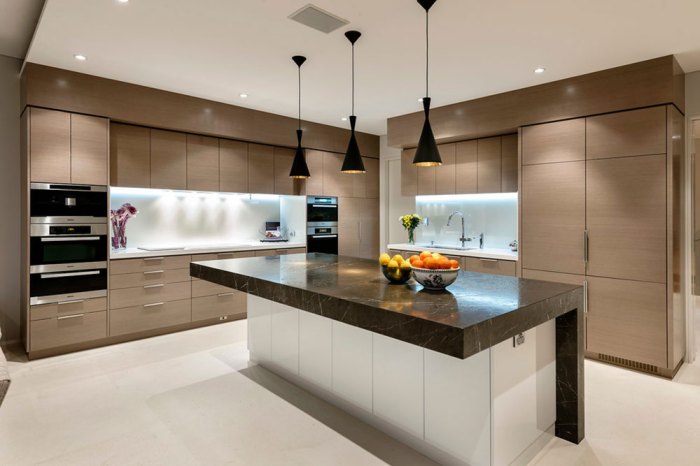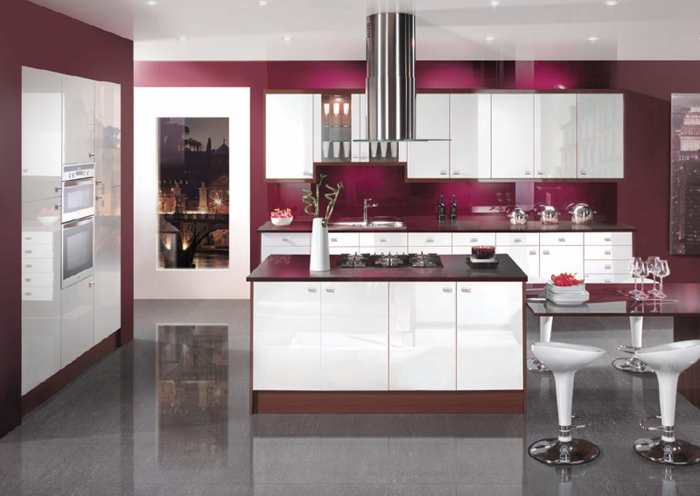Kitchen interior design sets the stage for this enthralling narrative, offering readers a glimpse into a story that is rich in detail and brimming with originality. From the importance of layout to the latest trends, this discussion delves deep into the heart of creating the perfect kitchen space.
As we explore the key elements, color schemes, layout optimization, and emerging trends, readers will uncover the secrets to designing a kitchen that not only looks stunning but also functions seamlessly.
Importance of Kitchen Interior Design
Having a well-designed kitchen is crucial in a home as it not only enhances the overall aesthetics but also improves functionality and efficiency.
Enhanced Functionality and Aesthetics
A well-designed kitchen with proper layout and organization can make meal preparation and cooking more convenient and enjoyable. For example, having ample storage space, easy access to utensils and ingredients, and efficient workflow can greatly enhance the functionality of the kitchen.
Additionally, a visually appealing kitchen with cohesive design elements can create a welcoming and comfortable environment for both residents and guests.
Impact on Workflow and Efficiency
The layout of a kitchen plays a significant role in the workflow and efficiency of cooking activities. For instance, a well-planned kitchen with a logical workflow from food preparation to cooking and cleaning can streamline the cooking process and save time.
Having essential kitchen items within reach and optimizing the placement of appliances can also contribute to a more efficient cooking experience.
Elements of Kitchen Interior Design
When designing a kitchen interior, there are several key elements to consider that can greatly impact the functionality and aesthetics of the space. From layout to materials, each element plays a crucial role in creating a well-designed kitchen.
Role of Lighting in Kitchen Design
Lighting is an essential element in kitchen design as it not only illuminates the space but also sets the mood and enhances the overall ambiance. Proper lighting can make a small kitchen feel more spacious and bright, while also highlighting key areas such as the countertop or stove.
- Consider installing a mix of overhead lighting, task lighting, and ambient lighting to ensure adequate illumination throughout the kitchen.
- Utilize under cabinet lighting to brighten up workspaces and create a warm, inviting atmosphere.
- Choose energy-efficient LED bulbs to reduce energy consumption and lower utility costs.
Importance of Storage Solutions in Kitchen Interiors
Effective storage solutions are crucial in kitchen interiors to keep the space organized, clutter-free, and functional. Proper storage can maximize space utilization and make it easier to access items when cooking or preparing meals.
- Install cabinets with pull-out shelves or drawers to optimize storage and make it easier to reach items at the back.
- Utilize vertical space by installing tall cabinets or shelving units to store pots, pans, and other bulky items.
- Incorporate built-in storage solutions such as spice racks, utensil holders, and pantry organizers to keep essentials within reach and neatly organized.
Color Schemes and Materials
When it comes to kitchen interior design, color schemes and materials play a crucial role in creating a cohesive and visually appealing space. The right combination of colors and materials can enhance the overall look and feel of your kitchen, making it a more inviting and functional area in your home.
Popular Color Schemes for Kitchen Interiors
- Neutral Colors: Shades of white, beige, gray, and taupe are popular choices for creating a timeless and versatile look in the kitchen. Neutral colors can make the space feel open, airy, and light.
- Bold and Vibrant Colors: Adding pops of bold and vibrant colors like red, blue, or green can create a focal point in the kitchen and add a sense of personality and energy to the space.
- Monochromatic Schemes: Using varying shades of the same color can create a sophisticated and harmonious look in the kitchen. This approach adds depth and visual interest without overwhelming the space.
Different Materials Used in Kitchen Design
- Countertops: Materials like granite, quartz, marble, and butcher block are popular choices for kitchen countertops due to their durability and aesthetic appeal.
- Cabinets: Wood, laminate, and metal are common materials used for kitchen cabinets, each offering different styles and finishes to complement the overall design.
- Flooring: Options such as hardwood, tile, vinyl, and laminate are popular choices for kitchen flooring, each with its own benefits in terms of durability and maintenance.
Choosing the Right Color Palette and Materials
- Consider the overall style and theme of your kitchen when selecting a color palette and materials to ensure a cohesive look throughout the space.
- Balance bold colors with neutral tones to create a harmonious and balanced design that is visually appealing.
- Take into account the practicality and maintenance of materials when choosing countertops, cabinets, and flooring to ensure they meet your lifestyle needs.
Layout and Space Optimization

When it comes to kitchen interior design, the layout and space optimization play a crucial role in creating a functional and aesthetically pleasing space.
Different Kitchen Layouts and Their Pros and Cons
- Galley Layout: This layout consists of two parallel walls of cabinets and countertops. Pros include efficient use of space and easy workflow. Cons can include a lack of openness and limited countertop space.
- L-Shaped Layout: This layout features cabinets and countertops along two adjacent walls, forming an L shape. Pros include ample storage and work surface. Cons may include limited flexibility in layout options.
- U-Shaped Layout: This layout utilizes three walls for cabinets and countertops, forming a U shape. Pros include plenty of storage and work space. Cons can include a potentially cramped feel in smaller kitchens.
Tips for Optimizing Space in Small Kitchens
- Utilize vertical space with tall cabinets or shelving to maximize storage.
- Opt for multi-functional furniture or appliances to save space.
- Consider using light colors and ample lighting to create the illusion of a larger space.
- Use wall-mounted racks or hooks for utensils and cookware to free up counter space.
Importance of the Work Triangle in Kitchen Design
In kitchen design, the work triangle refers to the relationship between the stove, refrigerator, and sinkthe three most commonly used areas in the kitchen. A well-planned work triangle ensures efficiency and smooth workflow in the kitchen. It is essential to maintain an optimal distance between these elements to enhance functionality and convenience while cooking.
Trends in Kitchen Interior Design

In today's rapidly evolving world, kitchen interior design trends are constantly changing to reflect the needs and preferences of homeowners. From smart kitchens to sustainable materials, modern kitchen interiors are embracing innovation and functionality like never before.
Smart Kitchens
Smart kitchens are becoming increasingly popular, with the integration of technology to make cooking and meal preparation more convenient. Features such as smart appliances, touchless faucets, and voice-activated assistants are revolutionizing the way we interact with our kitchens. These technological advancements not only enhance the overall cooking experience but also add a touch of modernity to the space.
Sustainable Materials
With a growing focus on sustainability and eco-friendliness, kitchen interior design is incorporating more sustainable materials. From recycled glass countertops to bamboo cabinetry, homeowners are opting for environmentally friendly options that reduce their carbon footprint. Not only do sustainable materials contribute to a healthier planet, but they also add a unique and stylish element to the kitchen space.
Timeless Design Elements
While trends come and go, there are certain design elements that stand the test of time. Classic features such as neutral color palettes, natural lighting, and minimalist design aesthetics continue to be popular choices for kitchen interiors. These timeless elements create a sense of elegance and sophistication that transcends passing trends, ensuring that your kitchen remains stylish for years to come.
Final Conclusion
In conclusion, the world of kitchen interior design is a fascinating blend of artistry and practicality. By understanding the significance of each element and staying abreast of the latest trends, anyone can transform their kitchen into a true masterpiece that reflects their unique style and personality.
Question Bank
Why is kitchen interior design important?
Kitchen interior design is crucial as it not only enhances the overall aesthetics of a home but also significantly impacts the functionality and efficiency of the space.
What are some popular color schemes for kitchen interiors?
Popular color schemes include classic white, bold black, calming blue, and earthy tones like beige and gray.
How can I optimize space in a small kitchen?
Optimizing space in a small kitchen can be achieved through clever storage solutions, utilizing vertical space, and choosing multi-functional furniture.
What are some current trends in kitchen interior design?
Current trends include the rise of smart kitchens with connected appliances, the use of sustainable materials, and the integration of technology for convenience.
Why is the work triangle important in kitchen design?
The work triangle, which connects the stove, sink, and refrigerator, is crucial in kitchen design as it ensures efficient workflow and easy access to essential areas while cooking.














